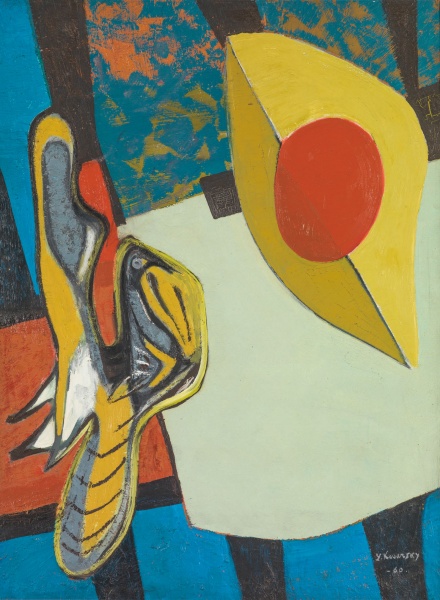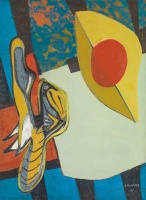
Still-Life
| Author: |
Yehoshua Kovarsky (1907–1967)  |
| Created: | 1960 |
| Material: | canvas |
| Technique: | oil |
| Dimensions: | 100 × 80 cm |
| Signature: | bottom right: Y. Kovarsky / – 60 |
These unrecognisable objects approaching abstraction look like rubbish: on the right of the picture is something resembling the remains of a poster or bright packaging. On the left is a configuration which resembles the shape of a dead bird. Both motifs were popular in Surrealism. The works of the Surrealist artists show metamorphoses which do not always go in the right direction. The combination of colours in this American-period picture by Yehoshua Kovarsky (1907–1967) does not seem to promise anything good. After the Second World War, the desire to create a mysterious and menacing atmosphere that was characteristic of Surrealist art was particularly appealing to Yehoshua Kovarsky, a Vilnius-born artist and graduate of schools in Bezalel, Jerusalem and Paris.
Text author Giedrė Jankevičiūtė
Fruits of Paradise. The Old Testament does not say what kind of fruit Adam and Eve tasted in the Garden of Eden, but after partaking of the fruit of the ‘knowledge of good and evil’ (Genesis 2:9), they covered themselves with fig leaves: ‘Then their eyes were opened, and they both realised that they were naked. They sewed fig leaves together and made coverings for themselves’ (Genesis 3:7). The fig tree is the first fruit tree mentioned in the Torah. The apple became a forbidden fruit much later, in the Vulgate (the translation of the Old Testament from Hebrew and Aramaic into Latin), because Latin has the same word for ‘evil’ and ‘apple’ (malus). When Albrecht Dürer depicted the first couple next to an apple tree in an engraving in 1504, and three decades later Lucas Cranach the Elder repeated this story, Christians no longer doubted that Eve had tempted Adam with an apple.
Twentieth-century artists offered new interpretations of the forbidden fruit. A wide range of fruits of the ‘knowledge of good and evil’ appear in Yehoshua Kovarsky’s still-lifes, while in the works of Samuel Bak, the fruit is a pear. Bak recalled how, as a child, he thought the fruit that gave the ability to distinguish between good and evil, and for which Adam was expelled from Paradise, should be a pear. He did not think it could be an apple, because in his childhood memories it was always sour (Samuel Bak, Painted with Words, 2009, p. 407). The pears that Bak depicted in his work for several decades symbolise a longing for the lost paradise and the childhood that was taken away from him by the Holocaust.
Text author Vilma Gradinskaitė
Source: Law firm Valiunas Ellex art album OBJECTS ON SHOW (2017). Compiler and author Giedrė Jankevičiūtė, STORIES OF LITVAK ART (2023). Compiler and author Vilma GradinskaitėExpositions: "Free and Unfree. Lithuanian Art between 1945 and 1990", 9 September 2021 – 30 April 2022, Lithuanian Art Centre TARTLE (Užupio St. 40, Vilnius). Curators Dovilė Barcytė and Ieva Burbaitė.







